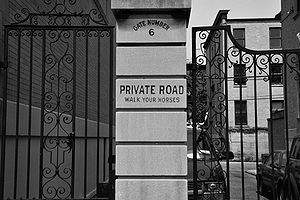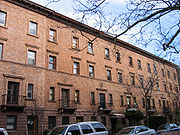
Strivers' Row
Encyclopedia

Townhouse
A townhouse is the term historically used in the United Kingdom, Ireland and in many other countries to describe a residence of a peer or member of the aristocracy in the capital or major city. Most such figures owned one or more country houses in which they lived for much of the year...
s in western Harlem
Harlem
Harlem is a neighborhood in the New York City borough of Manhattan, which since the 1920s has been a major African-American residential, cultural and business center. Originally a Dutch village, formally organized in 1658, it is named after the city of Haarlem in the Netherlands...
, in the New York City
New York City
New York is the most populous city in the United States and the center of the New York Metropolitan Area, one of the most populous metropolitan areas in the world. New York exerts a significant impact upon global commerce, finance, media, art, fashion, research, technology, education, and...
borough
Borough (New York City)
New York City, one of the largest cities in the world, is composed of five boroughs. Each borough now has the same boundaries as the county it is in. County governments were dissolved when the city consolidated in 1898, along with all city, town, and village governments within each county...
of Manhattan
Manhattan
Manhattan is the oldest and the most densely populated of the five boroughs of New York City. Located primarily on the island of Manhattan at the mouth of the Hudson River, the boundaries of the borough are identical to those of New York County, an original county of the state of New York...
on West 138th and West 139th between Adam Clayton Powell Jr. Boulevard
Seventh Avenue (Manhattan)
Seventh Avenue, known as Adam Clayton Powell Jr. Boulevard north of Central Park, is a thoroughfare on the West Side of the borough of Manhattan in New York City. It is southbound below Central Park and a two-way street north of the park....
and Frederick Douglass Boulevard
Eighth Avenue (Manhattan)
Eighth Avenue is a north-south avenue on the West Side of Manhattan in New York City, carrying northbound traffic. Eighth Avenue begins in the West Village neighborhood at Abingdon Square and runs north for 44 blocks through Chelsea, the Garment District, Hell's Kitchen's east end, Midtown and the...
. Originally called the "King Model Houses" after developer David King
David King
David or Dave King may refer to:In sports:*David King , Australian rules footballer for the Kangaroos Football Club*Dave King , Scottish businessman, Rangers F.C...
, they were designed for upper middle class whites and constructed between 1891 and 1893. Different architects worked on each of the three rows, and they are collectively recognized as a gem of New York City architecture
Architecture
Architecture is both the process and product of planning, designing and construction. Architectural works, in the material form of buildings, are often perceived as cultural and political symbols and as works of art...
.
The northern part of the 139th street group was completed by McKim, Mead and White in neo-Italian style. Designers who contributed to the complex on 138th street include James Lord Brown, Bruce Price
Bruce Price
Bruce Price was the American architect of many of the Canadian Pacific Railway's Château-type stations and hotels...
, and Clarence S. Luce.
The houses sit back-to-back with each other, which allowed King to specify that they would share rear courtyards. The alleyways between them are gated off (some entrance gates still have signs that read "Walk Your Horses"). At one time, these alleys allowed discreet stabling of horses and delivery of supplies without disrupting the goings-on in the main houses. Today, the back areas are used almost exclusively for the parking of cars. Strivers' Row houses are among the few private homes in Manhattan with space for parking, but also among the few townhouses that do not have gardens in the rear.

Black people
The term black people is used in systems of racial classification for humans of a dark skinned phenotype, relative to other racial groups.Different societies apply different criteria regarding who is classified as "black", and often social variables such as class, socio-economic status also plays a...
. As a result, they sat empty. When they were finally made available to black residents, for US$8000 each, they attracted hard-working professionals, or "strivers," who gave the houses their current name.
"Between Seventh and Eighth Avenues, is 139th Street, known among Harlemites as "strivers' row." It is the most aristocratic street in Harlem. Stanford White designed the houses for a wealthy white clientele. Moneyed African-Americans now own and inhabit them. When one lives on "strivers' row" one has supposedly arrived. Harry Rills resides there, as do a number of the leading Babbitts and professional folk of Harlem."
Among those who lived in Strivers' Row were Eubie Blake
Eubie Blake
James Hubert Blake was an American composer, lyricist, and pianist of ragtime, jazz, and popular music. In 1921, Blake and long-time collaborator Noble Sissle wrote the Broadway musical Shuffle Along, one of the first Broadway musicals to be written and directed by African Americans...
, Fletcher Henderson
Fletcher Henderson
James Fletcher Hamilton Henderson, Jr. was an American pianist, bandleader, arranger and composer, important in the development of big band jazz and swing music. His was one of the most prolific black orchestras and his influence was vast...
, Vertner Tandy
Vertner Tandy
Vertner Woodson Tandy was one of the seven founders of Alpha Phi Alpha fraternity at Cornell University in 1906. Before transferring to Cornell, Vertner studied architecture at Tuskegee University...
, W. C. Handy
W. C. Handy
William Christopher Handy was a blues composer and musician. He was widely known as the "Father of the Blues"....
, Dr. Louis T. Wright
Louis T. Wright
Louis Tompkins Wright was an American surgeon noted for his work in Harlem. The Spingarn Medallist played a major role in investigating the use of Aureomycin as a treatment on humans....
, Henry Pace, heavyweight boxer Harry Wills
Harry Wills
240px|rightHarry "The Black Panther" Wills was perhaps the most well known victim of the "color line" drawn by white heavyweight champions after the title reign of Jack Johnson...
, comedian Stepin Fetchit
Stepin Fetchit
Stepin Fetchit was the stage name of American comedian and film actor Lincoln Theodore Monroe Andrew Perry....
, actor/singer Bill "Bojangles" Robinson, and preacher/congressman Adam Clayton Powell Jr.
By the 1940s, many of the houses had decayed and were converted to single room occupancies
Single Room Occupancy
A single room occupancy is a multiple-tenant building that houses one or two people in individual rooms , or to the single room dwelling itself...
(SROs). Much of the original decorative detail inside the houses was lost at this time, though the exteriors generally remained unaltered. With the post-1995 real estate boom in Harlem, many of these buildings are being restored to something resembling their original condition.
Time Out New York, a New York publication, ran a cover story where they ranked "The 50 Best Blocks in New York City." All 5 boroughs were included in the ranking that was based on seven criteria: aesthetics, amenities, "green factor," noise and traffic, public transit, "New York-ocity," and affordability. Strivers' Row ranked 16th on this list.
Every one of the Strivers' Row houses is a designated landmark
Landmark
This is a list of landmarks around the world.Landmarks may be split into two categories - natural phenomena and man-made features, like buildings, bridges, statues, public squares and so forth...
. The buildings afford a view of the City College of New York
City College of New York
The City College of the City University of New York is a senior college of the City University of New York , in New York City. It is also the oldest of the City University's twenty-three institutions of higher learning...
, atop the hill to the west.
Jazz
Jazz
Jazz is a musical style that originated at the beginning of the 20th century in African American communities in the Southern United States. It was born out of a mix of African and European music traditions. From its early development until the present, jazz has incorporated music from 19th and 20th...
saxophonist Sonny Rollins
Sonny Rollins
Theodore Walter "Sonny" Rollins is a Grammy-winning American jazz tenor saxophonist. Rollins is widely recognized as one of the most important and influential jazz musicians. A number of his compositions, including "St...
, a Harlem native, named a contrafact of Charlie Parker
Charlie Parker
Charles Parker, Jr. , famously called Bird or Yardbird, was an American jazz saxophonist and composer....
's "Confirmation" after Striver's Row. This performance is available on the 1958 Album "A Night At The Village Vanguard
Night at the Village Vanguard
A Night at the Village Vanguard is an album by Sonny Rollins. The album was identified by Scott Yanow in his Allmusic essay "Hard Bop" as one of the 17 Essential Hard Bop Recordings.-Reception:...
".
Jazz
Jazz
Jazz is a musical style that originated at the beginning of the 20th century in African American communities in the Southern United States. It was born out of a mix of African and European music traditions. From its early development until the present, jazz has incorporated music from 19th and 20th...
singer Cab Calloway
Cab Calloway
Cabell "Cab" Calloway III was an American jazz singer and bandleader. He was strongly associated with the Cotton Club in Harlem, New York City where he was a regular performer....
mentions Striver's Row in his song "Hard Times (Topsy Turvy)"
Abram Hill's 1940 satirical comedy of manners, "On Strivers Row", produced with the American Negro Theatre (ANT), concerns "the follies of both social climbing and subtle racism among African Americans during Harlem's Renaissance".
Strivers' Row was also mentioned in the song, "Harlem Blues" on the soundtrack to the movie, "Mo' Better Blues".

